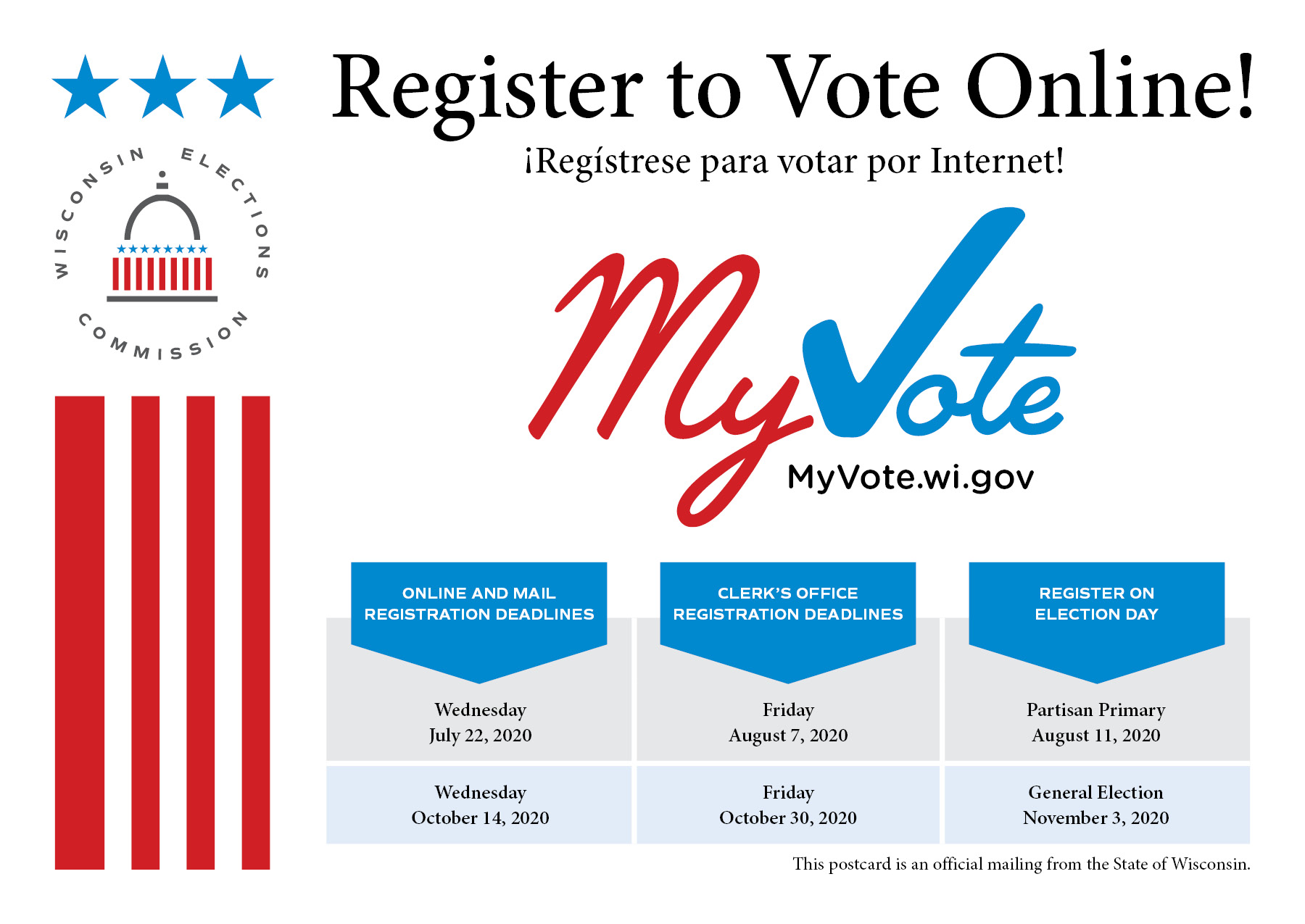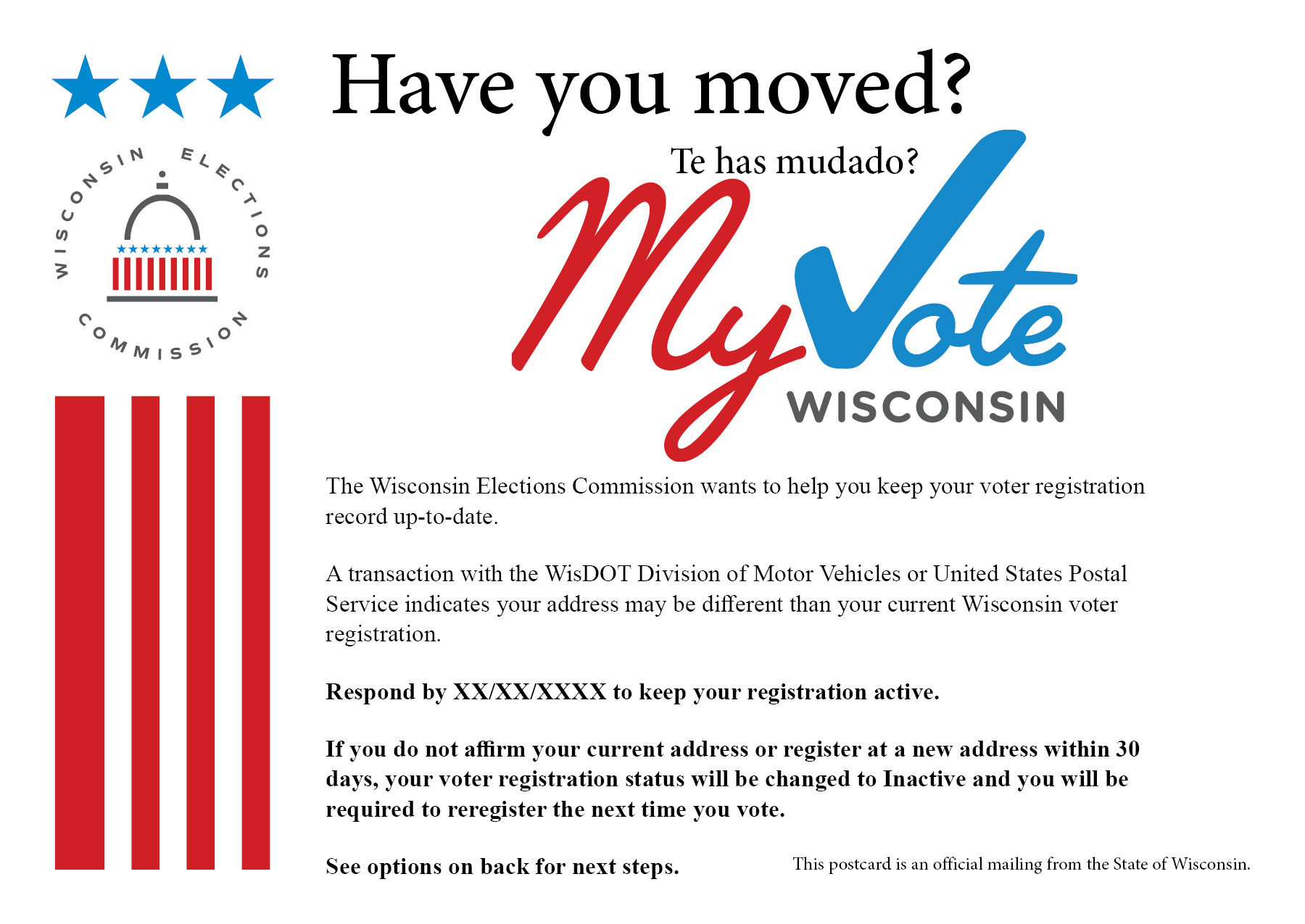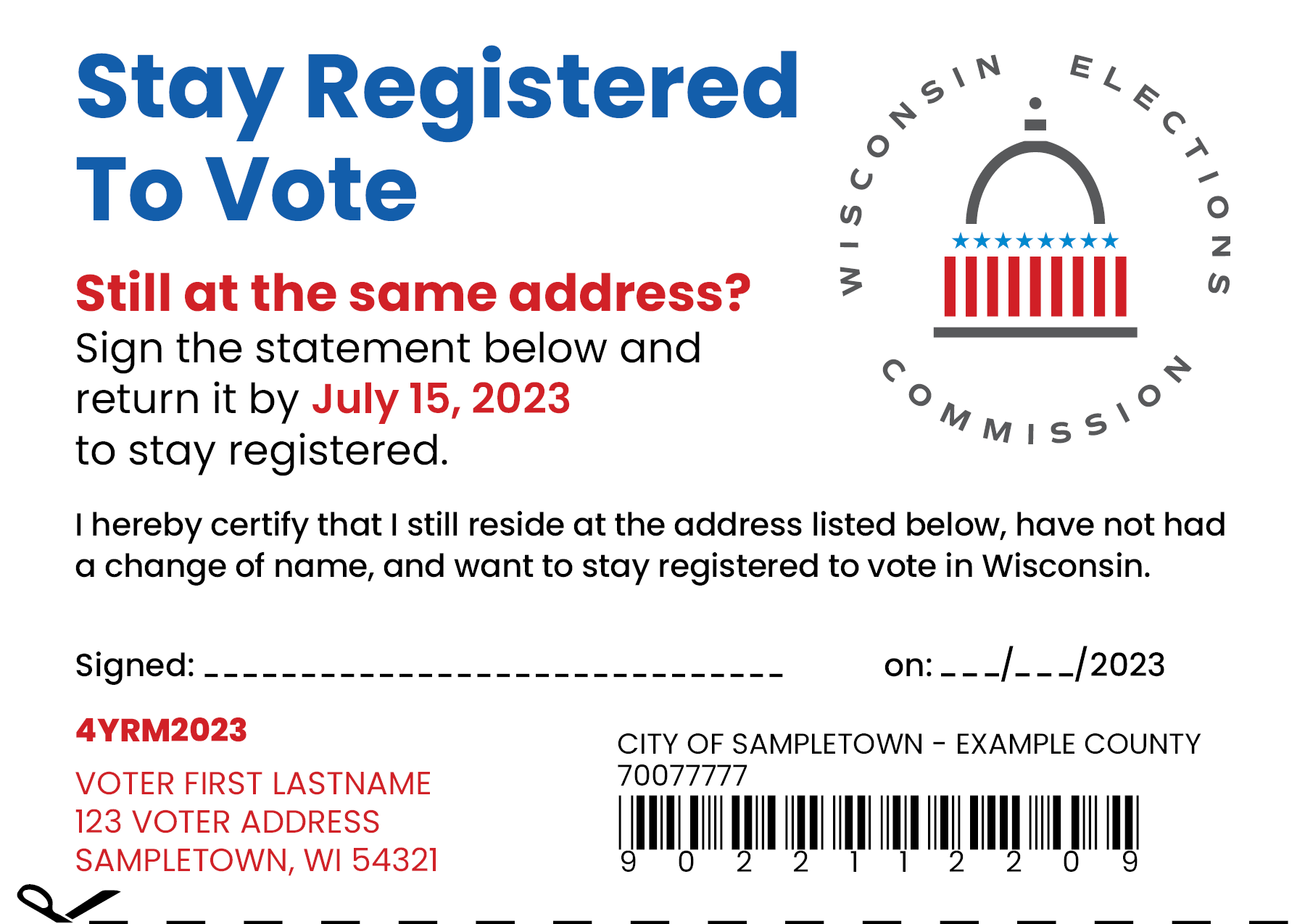Hablo Español -- I speak Spanish
Formas y Recursos
Si usted habla español, hay 20 formas de administración de elecciones traducidas, recursos y avisos del lugar de votación disponibles en nuestro sitio Web. Además de formas en español disponibles anteriormente, como el solicitud de inscripción de votante (EL-131) y la solicitud de papeleta para elector ausente (EL-121), el W.E.C. ahora está proveyendo materiales adicionales para los votantes y funcionarios electorales.
Todos los avisos de lugar de votación requerido también han sido traducidos. Además, hay otros recursos como instrucciones de voto provisionales en español. Versiones imprimibles y descargables de los documentos pueden encontrarse en la sección 'Formularios' en nuestra página Web.
Asistencia de lugar de votación
Cuando vaya a votar, usted puede ser acompañado por una persona que le asista en el proceso de votación, siempre que la persona no sea su empleador o su representante sindical. El asistente puede acompañarlo en el área de votación y traducir para usted el contenido de la boleta. El asistente no necesita ser un votante elegible o mayor de 18 años para ayudarle.
La ley federal mandata a la Ciudad de Milwaukee a ofrecer materiales electorales en español, incluyendo una boleta traducida, en todos los lugares de votación. Igualmente, funcionarios electorales bilingües deben estar disponibles en lugares de votación designados para proveer asistencia.
Forms and Resources
If you speak Spanish, there are 20 translated election administration forms, resources and polling place notices available on our website. In addition to previously available Spanish-language forms such as the Voter Registration Form (EL-131) and the Absentee Ballot Application (EL-121), the W.E.C. is now providing additional materials for use by voters and election officials.
All required polling place notices have also been translated. In addition, other resources such as Spanish-language provisional voting instructions have been created. Printable and downloadable versions of the documents can be found in the ‘Forms’ section on our website.
Polling Place Assistance
You may bring someone with you to the polls to assist you with the voting process, as long as the person assisting you is not a representative of your union or your employer. The assistor can go with you into the voting area and translate the ballot and voting instructions for you. The assistor does not have to be an eligible voter, or of voting age, to help you.
2024 General Election Info Hub
Here are the most commonly referenced topics, reports, guidance, and other documents for the November 5, 2024 General Election.
Important Note Regarding 2024 General Election Candidate Tracking Documents
Due to the recent passage of 2023 Wisconsin Act 94 creating new legislative district maps, there are important considerations to keep in mind when reviewing the 2024 candidate tracking documents.
Statistics & Reports
Counties & Municipalities
Recent News
Election Notices from the WEC
Type A - Notices of Elections
The Type A Notice is an “announcement” that an election will occur in the near future. The Type A Notice lists the offices up for election and the current incumbents.
Type C Notices
The Type C Notice is different from the Type A Notice of Referendum. It includes the resolution that directed the referendum, as well as an explanatory statement which describes the effect of a ‘yes’ or ‘no’ vote.
A copy of the Type C Notice must be provided to municipal clerks for posting at each polling place on Election Day.
Recent Notices
Other Notices
The Type B Notice provides instructions to electors on the procedures for voting a ballot and also includes a sample ballot. These notices are not published by the WEC, but by Municipal and County Clerks.
Date of Publication
The Type B Notice is published the day before the primary and election, or if a weekly paper is used, in the closest preceding issue. The Type B Notice is also posted at the polling place on election day along with two sample ballots.
The Type D Notice is published for any regularly-scheduled* or special primary or election at which municipal, federal, state, county, municipal or school district or referenda appear on the ballot.
Date of Publication
The Type D Notice is published the day before the primary and election, or if a weekly paper is used, in the closest preceding issue. The Type D Notice is also posted at the polling place on election day.
The Type E Notice informs the public of the times and locations where absentee voting is conducted for any regularly-scheduled* or special primary or election at which federal, state, county, municipal or school district offices or referenda appear on the ballot.
Date of Publication
The Type E Notice is published on the 4th Tuesday preceding a primary or election.
Filing Candidate Paperwork at WEC
Candidates or their representatives may submit nomination papers in-person at the Wisconsin Elections Commission office. To make this process as efficient as possible, candidates should make an appointment to submit nomination papers to Commission staff. However, our office does accept walk-in submissions.
Making an Appointment and Preparing to File:
Appointments are available weekdays between 9:00 a.m. and 4:00 p.m. Please note that the Elections Commission will be closed on Christmas Eve (12/24/2024), Christmas Day (12/25/2024), New Year's Eve (12/31/2024) and New Year's Day (1/1/2025).
Organize your papers prior to arriving at the WEC office and number each petition page in sequential order.
Arriving for your appointment:
The WEC office is located at 201 W. Washington Ave. Madison, WI 53703. The entire building is locked, and visitors must sign in with the front desk staff before being guided to the WEC office on the second floor. Appointments are scheduled for 30 minutes, however most appointments take around 15 minutes.
Appointments on the Deadline
Appointments on the deadline, January 7, 2025, are only available on a first come, first served basis. Please plan extra time if you are planning on turning in your papers on January 7 as there may be a wait.
Book Your Filing Appointment Today!
Appointments are available between 9a & 4p, Mon-Fri. WEC offices are closed on 12/24 & 25, and 12/31 & 1/1.
Voter Correspondence
Voter Correspondence
It's an even-numbered year, the weather is hot, and your mailbox is overflowing with political advertisements. You didn't sign up for this and you're wondering how they even got your address (read about that here). Since the 2010 Citizen's United v. Federal Election Commission ruling, campaign advertising has exploded. Some third-party mailpieces even include unsolicited election application forms and look like they are coming from an official source, which can raise suspicions and cast doubt on the election process (read about that here and here). We know that this deluge of mail can be frustrating, but please know that the Wisconsin Elections Commission and your local municipal clerk will only send you mail when it is absolutely necessary.
Look for the Official Election Mail logo!

The Official Election Mail logo is reserved exclusively for governmental election offices to use on correspondence with citizens of the United States for the purpose of participating in the voting process. Election officials may not always include this logo, but if you see it, you know that it is election mail – not political mail. The logo helps voters and letter carriers alike distinguish this official communication from the torrent of mail sent by candidates, PACs, and other advocacy groups.
The logo can be used on any sort of mail that enables voter participation like registration and absentee applications, balloting materials, polling place notifications, and other important messages. It should only come from a unit of government that administrates elections.
So what do we send?
The Wisconsin Elections Commission will only send you correspondence about your registration status or respond to requests that come from you.

Eligible, but Unregistered (EBU) Postcard
These postcards are sent every even year prior to a General Election. The people who receive this postcard have been issued either a driver license or state ID card from the Wisconsin Department of Transportation (WisDOT) that could not be matched to an active voter record in WisVote. The postcard asks the voter to register or check their registration status on myvote.wi.gov. The postcard also includes a toll-free number which routes them to the WEC Help Desk.
These mailings are not tracked in WisVote and will not result in any voters being deactivated.
People who receive the postcard may choose to register by mail, at their clerk’s office, at their polling place on Election Day, or on MyVote.wi.gov. The postcard can be used as proof of residence (POR) if the name and address on the postcard match the information on the registration form.
- No action necessary if the card is returned undeliverable
- If voters inquire, direct them to registration resources, in-person, on paper or via MyVote.wi.gov
- If voters use this card as proof of residence (POR), mark the POR Type of “Other Government Document” and POR Entity of WEC in WisVote. It is not necessary to enter a POR Account # since there is no account or tracking number on the card

Voter Verification & Election Day Registration Postcard
These postcards are sent out to anyone that registers to vote by mail, online at MyVote.wi.gov, or on Election Day. They are sent as an additional registration verification mechanism.
If the information on the postcard is correct, then no further action is necessary. Voters should contact their clerk if they notice any inaccurate information.
- Review returned postcards for data entry errors. Update the voter registration if needed and have the WEC Help Desk send another verification postcard.
- Record all returned EDR postcards on WisVote
- Additional information is available in the WisVote manual Section 2.7 and in the EDR instructions.

Movers Notification Postcard
Postcards are mailed to Wisconsin residents who were identified as potentially moving in the previous quarter. Information from the Wisconsin Department of Transportation, the National Change of Address database and other states is used to generate these mailings.
The postcards are mailed quarterly and can be identified by the “Have you moved?” header. The Postcard directs the voter to affirm their current address if it has not changed or reregister at their new address.
Voters who have not moved may affirm their current address by signing and returning the postcard, visiting MyVote.wi.gov, or voting in the next election where they can confirm with poll workers that their address has not changed. Voters who have moved may reregister by mail, at their clerk’s office, at their polling place on Election Day, or on MyVote.wi.gov.
- Mark the Mail record if the postcard is returned (Mailings tile on WisVote)
- Send Undeliverable 30-day Notice letter as necessary (available on Voter Record-Letters)
- Additional information is available on WisVote News and in related Clerk Communications

4-Year Maintenance (4YM) Postcard
The Wisconsin Elections Commission sends these out in the odd-numbered years to voters who have not voted in the previous four years. Voters who receive this postcard can sign and return it if they want to stay registered to vote. If the clerk does not receive the response by July 15 of an odd-numbered year, the voter’s registration will be deactivated. Voters can reregister (if they still meet Wisconsin's voting requirements) online, by mail, at your clerk's office, and at their polling place on Election Day.
People who receive the postcard and want to keep their voter record active can sign and return it by the July 15 deadline. They may also choose to reregister by mail, at their clerk’s office, or at their polling place on Election Day, or on MyVote.wi.gov.
- Mark the Mail record if the postcard is returned (Mailings tile on WisVote) by the deadline
- If voters inquire, direct them to registration resources, in-person, on paper or via MyVote.wi.gov
- Additional information is available on WisVote News and in related Clerk Communications